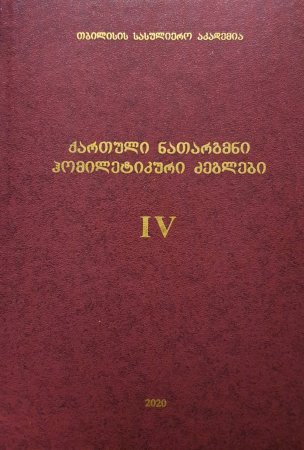Most of them were translated into
Georgian during the pre-Athonic period (up to the end of the 10th
century) by anonymous translators and were collected in collections
of homiletic-hagiographic texts of the 8th-9th centuries, called
“Mravaltavi” (Books of multiple texts). Two of the sermons whose
author is Saint Sophron of Jerusalem († 638) and are translated
into Georgian by Eprem Mtsire (9th c) represent an exception. Among
the texts on the Baptism, St. Nino’s († 338) homily is
pseudo-epigraphic and is considered to be an anti-Arianic
writing.
Julian of Tabis (the 5th century)
is unknown in Christian Literature and the content of his homily is
of anti-Monophysitic nature.
The source of the homily on the
Baptism by Cyril of Jerusalem († 386) is found to be his own
Catechesis III (PG 33, col. 425-450).
The author of two more homilies
on the Baptism is Gregory of Nyssa († 394). The second of these two
is a continuation of the first one, and is to be pronounced the
following week after the feast of the Baptism of the Lord.
The first homily is known in
Georgian sources as the one whose author is St. John Chrysostom (as
well as in Syriac sources); however, according to a Greek source it
is attributed to Gregory the Wonderworker († 270) (PG 10, col.
1177-1189). The surviving abridged Latin version of the same homily
is known as the one of Gregory of Antioch (6th c.) (PG 88, col.
1865-1872).
The Greek text of the second
homily is known as of the authorship of St. John Chrysostom (PG 64,
col. 33-38) and of Gregory of Antioch (PG 88, col. 1871-1884), and
its fragment is quoted in the work De Sacris Parallelis (PG 96,
col. 509-512) and works of Gregory of Nyssa which are considered as
lost ones (PG 46, col. 1109-1112).
In the homiletic literature
translated into Georgian, there are seven more homilies on the
Baptism known as those of John Chrysostom († 407). Of these seven,
the Greek source of only one text is identified for certain (PG 50,
col. 805-808). Therefore, today the rest of them are considered as
Georgian versions.
The homily on the Baptism of
Saint Proclus of Constantinople († 446) (PG 65, col. 757-764) can
be found in two Georgian translations.
The first text, which is included
in the Mravaltavi, represents a pre-Athonic translation, while the
second one is taken from the Russian Prologue-Synaxis (17th
century), presumably by the Georgian royal, King Archil
(1647-1713). In the Prologue-Sinaxis, which is translated from
Russian, there can be found another homily known as the one
belonging to Proclus: its Greek source is unknown.
The homily on the Baptism by
Pseudo-Eusebius of Alexandria (5th c.) (PG 86, col. 372-380) is
preserved in two ancient Georgian translations. One of them is
included in the Athonic Mravaltavi and is translated from the Greek
source, while the other is preserved in the Tbeti and Parkhali
Mravaltavi and contains obvious Armenianisms.
It should be noted that compared
to the Greek text, in the Georgian versions six passages have been
added, which indicates the existence of an extensive edition of the
Greek text.
Due to the large volume of the
material, we were not able to include in this volume the homilies
by Saint Gregory of Nazianzus which are translated into Georgian by
three translators (Saint Euthymius the Athonite, Ephrem Mtsire and
David of Tbeti). The following edition of the series will be
dedicated to this material.





